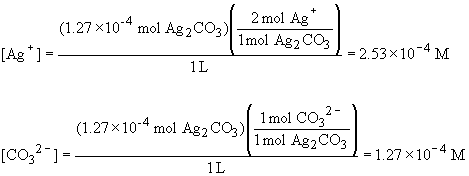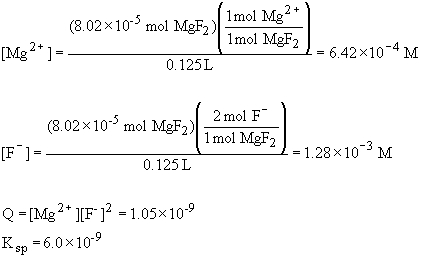
Chemistry Homework Assignment #6
Kotz & Treichel: Chapter 19
21) The problem states that 34.9 mg of Ag2CO3
(or 1.266 ´ 10-4 mol) will
dissolve in 1.0 L of pure water. For this compound, Ksp
= [Ag+]2[CO32-]. Thus, to calculate
Ksp,
the concentrations of the individual ions must be determined.

Therefore, Ksp = 8.14 ´
10-12
29) The solubility equilibrium of PbBr2 (FW=367.0 g/mol) is:
PbBr2 (s) « Pb2+(aq)
+ 2 Br- (aq) ![]() Ksp = [Pb2+][Br-]2
Ksp = [Pb2+][Br-]2
| Pb2+ (M) | Br- (M) | |
| Initial | 0 | 0 |
| D | x | 2x |
| Final | x | 2x |

b)
35) In these problems, we calculate the reaction quotient, Q, of the equilibrium process based on the assumption that all of the salt dissolves. If Q > Ksp, then the solute concentration would exceed its equilibrium value and, therefore, some will remain undissolved when equilibrium is established. If Q < Ksp, the entire sample will dissolve before equilibrium is established.
a) For 5.0 mg of MgF2 (FW = 62.31 g/mol) in 125 mL, we have,

Since Q < Ksp, the equilibrium will shift to the right,
i.e, more MgF2 could be dissolved. Therefore the entire sample
is dissolved before equilibrium is established.
b) By the same reasoning as above, for 0.50 g of CaF2 in 95 mL,
[Ca2+] = 6.74 ´ 10-2 M; [F-] = 1.35´ 10-1 M
Q = [Ca2+][F-]2 = 1.22´ 10-3
Ksp = 3.9´ 10-11
Since Q > Ksp, the equilibrium will shift to the left, i.e.,
solid CaF2 would precipitate from solution. Therefore, we can
say that some of the sample remains undissolved when equilibrium is established.
39) This problem also involves the comparison of Q to Ksp.
[Pb2+] = 0.0012 M; [Cl-] = 0.216 M
Q = [Pb2+][Cl-]2 = 5.6 ´ 10-5
Ksp = 1.7 ´ 10-5
Therefore, Q > Ksp and PbCl2 will precipitate from solution.
53) The solubility equilibrium of BaF2 (FW = 175.3 g/mol) is:
BaF2 (s) « Ba2+(aq)
+ 2 F- (aq) ![]() Ksp
= [Ba2+][F-]2
Ksp
= [Ba2+][F-]2
| Ba2+ (M) | F- (M) | |
| Initial | 0 | 0 |
| D | x | 2x |
| Final | x | 2x |

b) In a solution containing 5.0 mg/mL of KF, the fluoride concentration
is 0.0862 M. Thus,
| Ba2+ (M) | F- (M) | |
| Initial | 0 | 0.0862 |
| D | x | 2x |
| Final | x | 0.0862 + 2x |

57) The best approach to this problem is to determine the sulfate concentration at which each ion will precipitate. The ion that precipitates with the lowest sulfate concentration will precipitate first.
For the precipitation of CaSO4, Ksp = 2.4 ´ 10-5

For the precipitation of PbSO4, Ksp = 1.8 ´ 10-8

Therefore lead will precipitate out first.
b) When calcium begins to precipitate, the sulfate concentration is 2.4 ´ 10-3 M. Thus, the lead concentration at this point will be:

61) The two reactions are:
AgBr (s) « Ag+ (aq) + Br- (aq) K = Ksp = 3.3 ´ 10-13
Sum: AgBr (s) + 2 NH3 (aq) « [Ag(NH3)2]+ (aq) + Br- (aq)Ag+ (aq) + 2 NH3 (aq) « [Ag(NH3)2]+ (aq) K = Kf = 1.6 ´ 107
The equilibrium constant for the sum, Knet = KspKf=
5.3 ´ 10-6
67) Of the silver salts listed, Ag2CO3 and Ag3PO4,
will show enhanced solubility in acidic solution. This is because the anions
of these salts are themselves weak bases, which will react with hydronium.
The decrease in anion concentration then allows an increase in cation concentration,
hence salt solubility, since the sum is a constant, Ksp.
AgI will not show this behavior since iodide has no basic properties (why?).
91) PbCO3 dissolves in acidic solutions for the reasons described above. When the salt dissolves, carbonate can react with hydronium by the reactions below:
CO32- + H3O+ « HCO3- + H2O
HCO3- + H3O+ « H2CO3 + H2O
Thus, in acid solutions, LeChâtelier's Principle predicts that
the equilibrium is shifted to the right in both reactions, thereby lowering
the concentration of CO32-. Since this value will
be diminished, the concentration of lead can then increase. The solubility
of PbCl2 will not increase in acidic solutions since Cl-
has no tendency to react with hydronium to form HCl.
93) Kidney stones of both calcium oxalate and calcium phosphate are
more likely to form in basic urine. This is because the equilibrium concentration
of the anions (bases) will be higher than they would be in acidic solutions.
This is because the basic anions would react with hydronium as described
in question 91.
98) The ALPO Question.
a) AlCl3 + H3PO4 ® AlPO4 + 3 HCl
b) This is a limiting reagent problem. You have 152 g of AlCl3 (1.14 mol) and 3.0 L of 0.75 M H3PO4 solution (2.25 mol). Therefore, AlCl3 is limiting and you can make a maximum of 1.14 mol of AlPO4 (139.02 g).
c) Ksp = 1.3 ´ 10-20 = [Al3+][PO43-]
At equilibrium, [Al3+] = [PO43-] = 1.14 ´ 10-10 M.
d) AlPO4 will be more soluble in acidic solutions since the phosphate ion is basic and will therefore react with hydronium.
e) For this problem, we need to calculate the concentration of the ions in the mixed solution (total volume = 4.00 L).
[Al3+] = 9.4 ´ 10-4 M; [PO43-] = 2.2 ´ 10-2 M
Q = [Al3+][PO43-] = 2.1 ´ 10-4 ; Q > Ksp, \ precipitate will form.
To find out how many grams of AlPO4 form, we treat this as
another limiting reagent problem. We have 3.75 ´
10-3 mol Al3+ and 8.75 ´
10-2 mol PO43-. Thus, we will obtain 3.75
´
10-3 mol of AlPO4 (0.457 g). As it turns out, the
remaining phosphate has a concentration of 2.1 ´
10-2 M, making the aluminum concentration a tiny 6.2 ´
10-19 M. This is about 10 aluminum ions per mL.